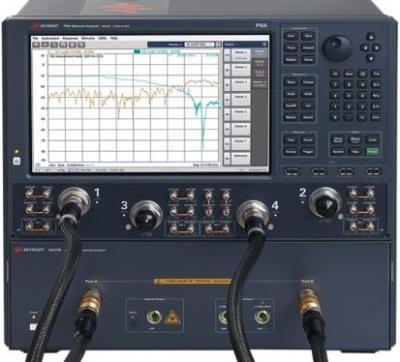
|
|
The Keysight N4373E Lightwave Component Analyzer (LCA) is the ideal choice to characterize such electro-optical components for 40G/100GbE, for 400 Gbit/s and 1 Tbit/s transmission systems. Using the advanced measurement capabilities of the new N52xxB series PNA Microwave Network Analyzers, all S-parameter related characteristics of the device under test, like responsivity and 3 dB-cutoff frequency, can be qualified from 10 MHz to 43.5 GHz, 50 GHz or 67 GHz.
Specifications.
Optical test set.
Operation frequency range: 10 MHz to 67 GHz (N5227B PNA), 10 MHz to 50 GHz (N5225B PNA), 10 MHz to 43.5 GHz (N5224B PNA).
LCA optical input.
Operating input wavelength range: 1290 nm to 1610 nm.
Maximum linear average input power;
Optical input 1:
+4 dBm @ 1310 nm,
+5 dBm @ 1550 nm.
Optical input 2:
+14 dBm @ 1310 nm,
+15 dBm @ 1550 nm.
Maximum safe average input power: +7 dBm (Input 1), +17 dBm (Input 2).
Optical return loss (typical): > 25 dBo.
Average power measurement range: -25 dBm to +5 dBm (optical input 1), -15 dBm to +15 dBm (optical input 2).
Average power measurement uncertainty (typical): ±0.5 dBo.
LCA optical output.
Optical modulation index (OMI) at 10 GHz (typical): > 27% @ +5 dBm RF power, > 47% @ +10 dBm RF power.
Output wavelength: 1310 ± 20 nm (Opt -100, -102), 1550 ± 20 nm (Opt -101, -102).
Average output power range: −1 dBm to +5 dBm @ 1550 nm, −2 dBm to +4 dBm @ 1310 nm .
Average output power uncertainty (typical): ± 0.5 dBo.
Average output power stability, 15 minutes (typical): ± 0.5 dBo.
External optical source input (-050).
Recommended optical input power: +8 to + 15 dBm.
Optical input power damage level: +20 dBm.
Typical loss at quadrature bias point: 9 dB.
Operating input wavelength range: 1290 nm to 1610 nm.
LCA RF test port input.
Maximum safe input level at port A or B: +15 dBm RF, 7V DC.
Options.
-100; 1310 nm source optical test set.
-101; 1550 nm source optical test set.
-102; 1310 nm and 1550 nm source optical test set.
-021; Straight FC/PC SM.
-022; Angled FC/APC SM.
S93010A; Time domain measurements.
-050; External optical input.
-240; 43.5 GHz, 2 ports, single source PNA (N5224B-200) and RF-cables.
-241; 43.5 GHz, 2 ports, single source PNA (N5224B-201) with configurable test set and RF-cables.
-242; 43.5 GHz, 2 ports, single source PNA (N5224B-219) with configurable test set, extended power range, bias-tees and RF-cables.
-250; 50 GHz, 2 ports, single source PNA (N5225B-200) and RF-cables.
-251; 50 GHz, 2 ports, single source PNA (N5225B-201) with configurable test set and RF-cables.
-252; 50 GHz, 2 ports, single source PNA (N5225B-219) with configurable test set, extended power range, bias-tees and RF-cables.
-270; 67 GHz, 2 ports, single source PNA (N5227B-200) and RF-cables.
-271; 67 GHz, 2 ports, single source PNA (N5227B-201) with configurable test set and RF-cables.
-272; 67 GHz, 2 ports, single source PNA (N5227B-219) with configurable test set, extended power range, bias-tees and RF-cables.
-440; 43.5 GHz, 4 ports, dual source PNA (N5224B-400) and RF-cables.
-441; 43.5 GHz, 4 ports, dual source PNA (N5224B-401) with configurable test set and RF-cables.
-442; 43.5 GHz, 4 ports, dual source PNA (N5224B-419) with configurable test set, extended power range, bias-tees and RF-cables.
-450; 50 GHz, 4 ports, dual source PNA (N5225B-400) and RF-cables.
-451; 50 GHz, 4 ports, dual source PNA (N5225B-401) with configurable test set and RF-cables.
-452; 50 GHz, 4 ports, dual source PNA (N5225B-419) with configurable test set, extended power range, bias-tees and RF-cables.
-470; 67 GHz, 4 ports, dual source PNA (N5227B-400) and RF-cables.
-471; 67 GHz, 4 ports, dual source PNA (N5227B-401) with configurable test set and RF-cables.
-472; 67 GHz, 4 ports, dual source PNA (N5227B-419) with configurable test set, extended power range, bias-tees and RF-cables.
|